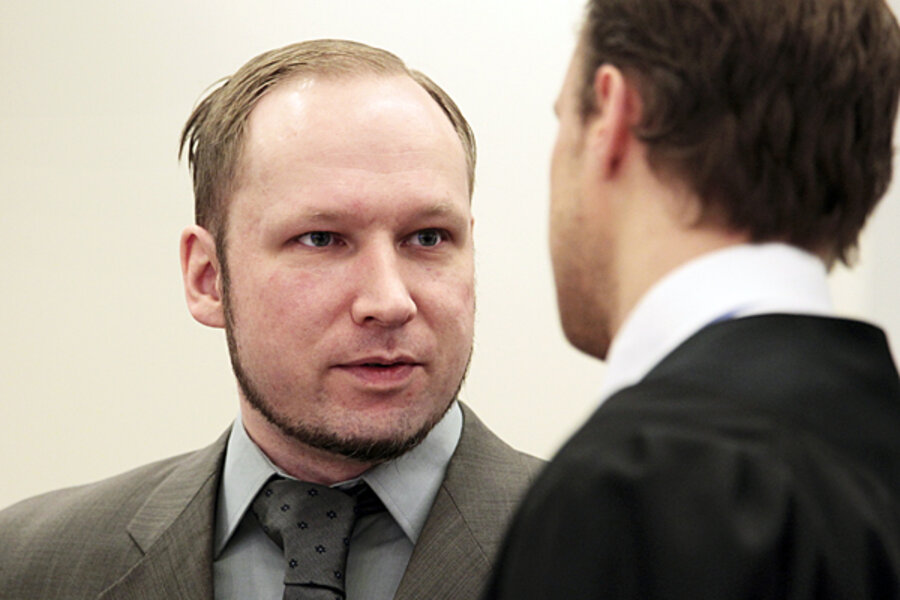Breivik says psychiatric report deeming him insane is full of 'fabrications'
Loading...
| Oslo
Anders Behring Breivik, the Norwegian behind last summer’s twin terror attacks, today blasted a forensic psychiatric report deeming him insane and warned his actions could be just the beginning of violence in Europe by militant nationalists.
In the sixth day of his court testimony, an adamant – but, as usual, composed – Mr. Breivik told prosecutors that 80 percent of the report by psychiatrists Torgeir Husby and Synne Sørheim, which diagnosed him with paranoid schizophrenia, was fabricated.
He accused the psychiatrists of being emotionally affected by the July 22 attacks that killed 77, mostly teenagers, and of not having enough knowledge of politically motivated violence to understand his terminology.
“I got the impression that they concluded very early,” Breivik told public prosecutor Svein Holden, saying the two doctors had constructed their diagnosis to support their conclusion. “That person they describe in the report is not me.”
He cited an example in which he was portrayed as bacteria-phobic because he sometimes wore a mouth mask while living with his mother after 2006. He told prosecutors he had used a particle-filter mask to protect himself from dust while drilling detonation cases in preparation for his attack.
He said that what the psychiatrists had experienced as “emotional flatness” was actually part of his military dehumanization training and Bushido meditation to ward off fear in order to prepare for his gruesome attack.
“Huseby told me about two patients who thought they were Jesus,” he said, referring to their claim he had said he would “single-handedly save” Europe. “I believe he meant that I should be the third case," Breivik said, denying that he ever said the word "save."
The crux of the case against Breivik hinges on his sanity after two conflicting forensic psychiatric reports. The first concluded in November that Breivik is insane and therefore not criminally punishable, but a second report earlier this month deemed he was not psychotic.
Breivik has said that he wants to be judged sane so that his anti-Islamic ideology is taken seriously. He admitted responsibility for the attacks, although he pled not guilty, claiming he was acting preventively against the ethnic cleansing of indigenous Norwegians, which was being promoted by the Labor party’s lenient immigration policies that resulted in an influx of Muslims.
He also criticized the conclusion of the second report, which described him as “narcissistic and dissocial” and dismissed the existence of a Knights Templar group, describing it as “sprung from his fantasy.” Breivik reiterated earlier statements made during testimony that he met with six people connected to a militant nationalist Knights Templar network and said more attacks could come from two others in the network.
If found sane, Breivik faces a maximum sentence of 21 years in prison for placing a car bomb outside government offices in Oslo, killing eight, and shooting and killing a further 69 on the Labor party’s youth summer camp at Utøya island.
The effort to determine Breivik’s sanity took an unexpected turn on April 23, when the court asked the second set of psychiatrists, Agnar Aspaas and Terje Tørrisen, to provide a supplementary statement following a request by the Norwegian Board of Forensic Medicine. The board was concerned that Breivik had given strategic replies, and also about the lack of information about his childhood and the period after 2006, when he moved back in with his mother.
Media outlets have reported, based on leaks from the confidential psychiatric reports, that Breivik was diagnosed as emotionally damaged as early as age four and was near to being forcibly removed from his mother. Breivik has refused to elaborate on his childhood.
Psychiatrist experts have warned not to read too much into the Forensic Board’s request for more information, as it typically requests additional comments in about one in three cases. The board did not have any comments on the first report in November.
Judge Wenche Elizabeth Arntzen informed the court today that the psychiatrists would deliver their supplementary report over the weekend. The case is expected to continue this week with testimony by those seriously injured by the government bomb blast.
Get daily or weekly updates from CSMonitor.com delivered to your inbox. Sign up today.







